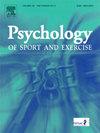心理干预降低了意大利运动员使用兴奋剂的可能性:复制与扩展》。
IF 3.1
2区 心理学
Q2 HOSPITALITY, LEISURE, SPORT & TOURISM
引用次数: 0
摘要
近年来,有关预防使用兴奋剂的研究激增,一些反兴奋剂干预措施的开发就是明证。然而,研究人员很少研究在一个人群中实施和评估的反兴奋剂干预措施在不同人群中是否同样有效。我们的研究旨在确定 Kavussanu 等人(2022 年)开发的心理干预措施(最初在英国和希腊运动员中实施)在预防意大利年轻运动员使用兴奋剂方面是否与标准教育干预措施同样有效(即通过影响我们的主要和次要结果)。通过对意大利 46 家俱乐部的 540 名运动员进行筛选调查,确定了符合条件的参与者。共有 15 个体育俱乐部(121 名运动员;16.95% 为女性;年龄为 18.52 ± 2.15 岁)被分配到三个条件之一:心理干预、教育干预或无干预对照组。每种干预措施都包括在六周内对运动员小组进行六次每次一小时的课程。运动员在干预前、干预后和两个月后分别完成了兴奋剂可能性、预期负罪感、道德脱离和自我调节效能的测量。对照组参与者在相同的时间点完成了相同的测量。从干预前到干预后,两种干预措施在降低使用兴奋剂的可能性和增加预期内疚感方面的效果相似,而对照组则没有变化;这些效果在随访中得以保持。与对照组相比,这两种干预措施都能从事前到事后减少道德偏离,提高自我调节效能,而且这些效果在后续研究中得以保持。总之,我们的研究大致重复了之前的研究结果,并强调了反兴奋剂组织在反兴奋剂教育中针对心理变量和兴奋剂相关信息的必要性。本文章由计算机程序翻译,如有差异,请以英文原文为准。
A psychological intervention reduces doping likelihood in Italian athletes: A replication and extension
Research on doping prevention has proliferated in recent years as evidenced by the development of several anti-doping interventions. However, researchers have rarely examined whether an anti-doping intervention delivered and evaluated in one population is similarly effective in a different population. The purpose of our research was to determine whether the psychological intervention developed by Kavussanu et al. (2022) and originally delivered in British and Greek athletes, was equally effective as a standard educational intervention in preventing doping (i.e., by influencing our primary and secondary outcomes) in young Italian athletes. Eligible participants were identified via a screening survey administered to 540 athletes from 46 clubs in Italy. A total of 15 sport clubs (121 athletes; 16.95 % female; aged 18.52 ± 2.15 years) were assigned to one of three conditions: a psychological intervention, an educational intervention, or a no-intervention control group. Each intervention consisted of six 1-h sessions delivered to small groups of athletes over six weeks. Athletes completed measures of doping likelihood, anticipated guilt, moral disengagement, and self-regulatory efficacy pre-intervention, post-intervention, and two months later. Control group participants completed the same measures at the same time points. The two interventions were similarly effective in reducing doping likelihood and increasing anticipated guilt from pre to post, while the control group showed no change; these effects were maintained at follow up. Both interventions reduced moral disengagement and increased self-regulatory efficacy from pre to post relative to the control group, and these effects were maintained at follow-up. In conclusion, our study broadly replicates previous findings and highlights the need for anti-doping organizations to target psychological variables and doping-relevant information in anti-doping education.
求助全文
通过发布文献求助,成功后即可免费获取论文全文。
去求助
来源期刊
CiteScore
6.40
自引率
5.90%
发文量
172
审稿时长
69 days
期刊介绍:
Psychology of Sport and Exercise is an international forum for scholarly reports in the psychology of sport and exercise, broadly defined. The journal is open to the use of diverse methodological approaches. Manuscripts that will be considered for publication will present results from high quality empirical research, systematic reviews, meta-analyses, commentaries concerning already published PSE papers or topics of general interest for PSE readers, protocol papers for trials, and reports of professional practice (which will need to demonstrate academic rigour and go beyond mere description). The CONSORT guidelines consort-statement need to be followed for protocol papers for trials; authors should present a flow diagramme and attach with their cover letter the CONSORT checklist. For meta-analysis, the PRISMA prisma-statement guidelines should be followed; authors should present a flow diagramme and attach with their cover letter the PRISMA checklist. For systematic reviews it is recommended that the PRISMA guidelines are followed, although it is not compulsory. Authors interested in submitting replications of published studies need to contact the Editors-in-Chief before they start their replication. We are not interested in manuscripts that aim to test the psychometric properties of an existing scale from English to another language, unless new validation methods are used which address previously unanswered research questions.

 求助内容:
求助内容: 应助结果提醒方式:
应助结果提醒方式:


